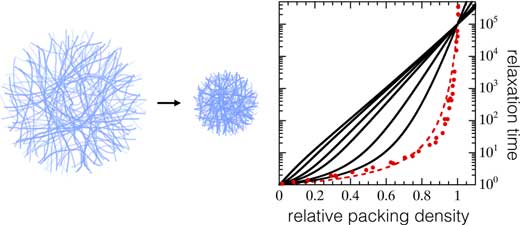| Posted: Jul 06, 2017 | |
Strength and weakness in nanoparticle glasses(Nanowerk News) Researchers in Greece propose a description for the microscopic mechanism of fragility transitions in glasses of compressible colloids, based on the regulation of osmotic equilibrium. |
|
| The team's work raises the intriguing possibility that the entire range of fragility and strength known to exist for molecular systems may be explored by studying glasses of colloids with varying softness. | |
| Using a simple phenomenological model, as reported in ACS Nano ("Fragility and Strength in Nanoparticle Glasses"), they show how apparent changes in fragility can arise when the particle softness is varied. | |
| The model is based on the osmotic deswelling of compressible colloids, which qualitatively captures fragility changes observed in colloidal glasses. | |
| The researchers find that the elastic energy per particle acts as an effective order parameter for the fragility of the glass transition. A qualitative comparison of their model with experimental data suggests that a fragile-to-strong transition can be induced not only by increasing particle softness but also by decreasing the particle size. | |
 |
|
| A simple model that explains fragility changes in colloidal glasses by describing the volume regulation of compressible colloids in order to maintain osmotic equilibrium. (© ACS) | |
| The team notes that the change from a fragile to a strong glass transition can be explained by a nonlinear relation between the experimental control parameter and the real particle volume fraction which dictates the dynamics of the suspension. The degree of nonlinearity depends only on the elastic energy per particle, which thus serves as an effective order parameter for fragility. | |
| As the elastic energy per particle scales inversely with particle volume, hard colloids may make strong glasses and soft colloids may make fragile glasses depending on nominal particle size, the particle\softness, and the equation-of-state of the bath. | |
| The authors point out that, while the phenomenological description they present provides new insight into the nature of the colloidal glass transition at the macroscopic scale, it does not yet account for spatial heterogeneity at microscopic length scales. | |
| "Experiments and simulations have shown that softness reduces both the magnitude and spatial extent of dynamical heterogeneities and extends the validity range of the Stokes-Einstein relation to higher packing densities," they conclude their report. "Perhaps this can be explained by the weaker dependence of relaxation time on local density for softer particles due to osmotic regulation. Extending the simple model proposed here to account for such local effects could aid in elucidating the intriguing connection between glass fragility and dynamical heterogeneity." |
 By
Michael
Berger
– Michael is author of three books by the Royal Society of Chemistry:
Nano-Society: Pushing the Boundaries of Technology,
Nanotechnology: The Future is Tiny, and
Nanoengineering: The Skills and Tools Making Technology Invisible
Copyright ©
Nanowerk LLC
By
Michael
Berger
– Michael is author of three books by the Royal Society of Chemistry:
Nano-Society: Pushing the Boundaries of Technology,
Nanotechnology: The Future is Tiny, and
Nanoengineering: The Skills and Tools Making Technology Invisible
Copyright ©
Nanowerk LLC
|
|
|
Subscribe to a free copy of one of our daily Nanowerk Newsletter Email Digests with a compilation of all of the day's news. |
